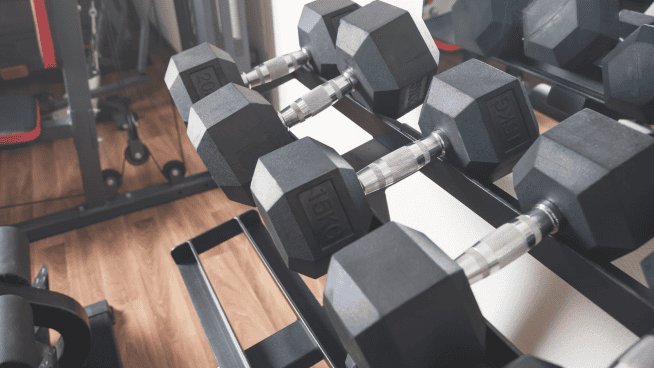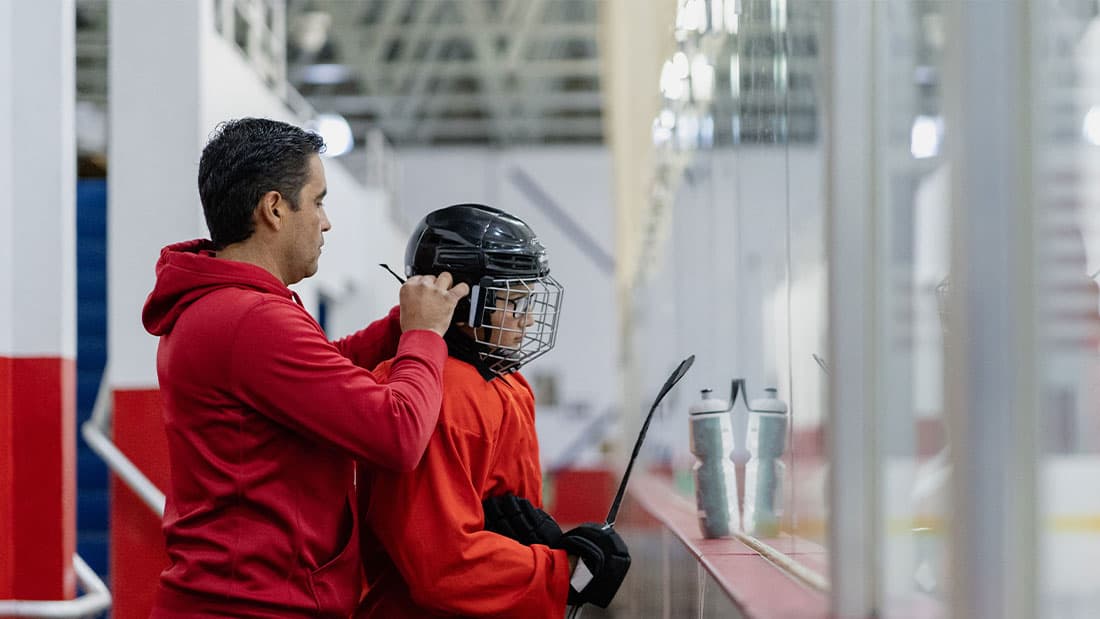Avoid a Playoff Collapse With This In-Season Hockey Workout Program
As a trainer, I see two hockey workout mistakes repeatedly. Both have the same outcome. Early-season success leads to a collapse in performance as the most important part of the season approaches, when more and more scouts are in the stands for games.
Mistake 1: Getting Lax
You failed to keep up with your off-ice hockey workouts once the season started. It’s easy to do and not really your fault. After all, you worked out during the off-season when you had lots of time. Then you had tryouts and a busy start to the season, and you just never got back on track. You convinced yourself that games and practices would keep you in “hockey shape.” Your team even has someone come in and do off-ice training with your team—you run stairs and do Push-Ups and Planks, so that helps, right?
OR
Mistake 2: Doing Too Much
You battled all season to keep up with your training as if it were still the off-season. You made sure you got to the gym at least four times per week to do your off-ice hockey training program from the summer. Each workout lasted 60-90 minutes, and you got a great sweat on.
You enjoy working out and love it when the coaches comment on how hard you work. They call you an “animal,” and that makes you proud.
RELATED: Is Overtraining Real?
Finding the Sweet Spot
Here are some rules to help you find exactly the right dose of off-ice training to help you perform your best on the ice, gain momentum during the season and minimize additional wear and tear on your body (you get enough of that on the ice.)
The idea is to train smart—to work hard on the right things rather than working hard for the sake of being an “animal.” Follow these rules, and you will be surprised how you gain momentum during the season so you will be playing your best hockey when the season is on the line—just like your team MVP does. Who knows? This season it could be you.
- Get into the gym 2-3 times per week.
- Focus on strength and power. That means lower rep ranges and heavier loads.
- Minimize your stamina-based energy system training unless you play only a few minutes per game or your practices are easy, with a lot of time devoted to teaching the systems rather than actually running through them at game speed. Five minutes of ice time will not be enough to keep you at your best through the season.
- Devote a small amount of time at least five days per week to work on body maintenance. This includes things like foam rolling or other forms of self-myofascial release, stretching, muscle activation and stabilization exercises. You do not need to spend hours working on this stuff. Even 15 minutes five days per week will be a huge improvement if you are not currently devoting any time to it.
Sample In-Season Hockey Workout
Mobility
- Foam Roll – quadriceps, hip flexors, glutes, lats, adductors. Spend approximately 30 seconds on each area on each side.
- Stretch/Mobilize – hip flexors, hamstrings, quadriceps, glutes, calves, thoracic spine.
Strength
- Rear Foot Elevated Split Squat – 3×4-6 each side
- DB Squat Jump – 3×4 with only 10-20 pounds of resistance
- Single-Arm Standing Cable Press – 3×4-6 each side
- Reverse Lunge to Step-Up – 3×4 each side
- Bear Position Row – 3×4-6 each side
- MB Rotary and Pass – 3×6
Energy System
If you are playing less than 15 minutes per game or if your practices are relatively easy, fit this energy system workout in 1-2 times per week. You can use the bike, treadmill, Stairmaster, elliptical or slideboard for this routine.
- Warm up for 5 minutes
- 20 seconds full out, 40 seconds easy – 5 reps
- 10 seconds full out, 20 seconds easy – 6 reps
- Go very easy for one minute
- 10 seconds full out, 20 seconds easy – 4 reps
- Go very easy for one minute
- 10 seconds full out, 20 seconds easy – 2 reps
- Go very easy for one minute
- 20 seconds full out, 40 seconds easy – 5 reps
- Done. In under 20 minutes.
Those of you who follow my other articles might be surprised to hear me say it’s OK to use the bike for your energy system workout. I actually don’t mind this during the season, because the goal is to get/keep you moving explosively on the ice and keep you healthy while adding minimal overload to the patterns you are already overusing.
That’s why you don’t see many high impact or big lateral movements in this workout. You are getting lots of impact and lateral movement on the ice, so we will leave it out there for now.
Learn more about hockey training to improve your game in-season.
RECOMMENDED FOR YOU
MOST POPULAR
Avoid a Playoff Collapse With This In-Season Hockey Workout Program
As a trainer, I see two hockey workout mistakes repeatedly. Both have the same outcome. Early-season success leads to a collapse in performance as the most important part of the season approaches, when more and more scouts are in the stands for games.
Mistake 1: Getting Lax
You failed to keep up with your off-ice hockey workouts once the season started. It’s easy to do and not really your fault. After all, you worked out during the off-season when you had lots of time. Then you had tryouts and a busy start to the season, and you just never got back on track. You convinced yourself that games and practices would keep you in “hockey shape.” Your team even has someone come in and do off-ice training with your team—you run stairs and do Push-Ups and Planks, so that helps, right?
OR
Mistake 2: Doing Too Much
You battled all season to keep up with your training as if it were still the off-season. You made sure you got to the gym at least four times per week to do your off-ice hockey training program from the summer. Each workout lasted 60-90 minutes, and you got a great sweat on.
You enjoy working out and love it when the coaches comment on how hard you work. They call you an “animal,” and that makes you proud.
RELATED: Is Overtraining Real?
Finding the Sweet Spot
Here are some rules to help you find exactly the right dose of off-ice training to help you perform your best on the ice, gain momentum during the season and minimize additional wear and tear on your body (you get enough of that on the ice.)
The idea is to train smart—to work hard on the right things rather than working hard for the sake of being an “animal.” Follow these rules, and you will be surprised how you gain momentum during the season so you will be playing your best hockey when the season is on the line—just like your team MVP does. Who knows? This season it could be you.
- Get into the gym 2-3 times per week.
- Focus on strength and power. That means lower rep ranges and heavier loads.
- Minimize your stamina-based energy system training unless you play only a few minutes per game or your practices are easy, with a lot of time devoted to teaching the systems rather than actually running through them at game speed. Five minutes of ice time will not be enough to keep you at your best through the season.
- Devote a small amount of time at least five days per week to work on body maintenance. This includes things like foam rolling or other forms of self-myofascial release, stretching, muscle activation and stabilization exercises. You do not need to spend hours working on this stuff. Even 15 minutes five days per week will be a huge improvement if you are not currently devoting any time to it.
Sample In-Season Hockey Workout
Mobility
- Foam Roll – quadriceps, hip flexors, glutes, lats, adductors. Spend approximately 30 seconds on each area on each side.
- Stretch/Mobilize – hip flexors, hamstrings, quadriceps, glutes, calves, thoracic spine.
Strength
- Rear Foot Elevated Split Squat – 3×4-6 each side
- DB Squat Jump – 3×4 with only 10-20 pounds of resistance
- Single-Arm Standing Cable Press – 3×4-6 each side
- Reverse Lunge to Step-Up – 3×4 each side
- Bear Position Row – 3×4-6 each side
- MB Rotary and Pass – 3×6
Energy System
If you are playing less than 15 minutes per game or if your practices are relatively easy, fit this energy system workout in 1-2 times per week. You can use the bike, treadmill, Stairmaster, elliptical or slideboard for this routine.
- Warm up for 5 minutes
- 20 seconds full out, 40 seconds easy – 5 reps
- 10 seconds full out, 20 seconds easy – 6 reps
- Go very easy for one minute
- 10 seconds full out, 20 seconds easy – 4 reps
- Go very easy for one minute
- 10 seconds full out, 20 seconds easy – 2 reps
- Go very easy for one minute
- 20 seconds full out, 40 seconds easy – 5 reps
- Done. In under 20 minutes.
Those of you who follow my other articles might be surprised to hear me say it’s OK to use the bike for your energy system workout. I actually don’t mind this during the season, because the goal is to get/keep you moving explosively on the ice and keep you healthy while adding minimal overload to the patterns you are already overusing.
That’s why you don’t see many high impact or big lateral movements in this workout. You are getting lots of impact and lateral movement on the ice, so we will leave it out there for now.
Learn more about hockey training to improve your game in-season.











